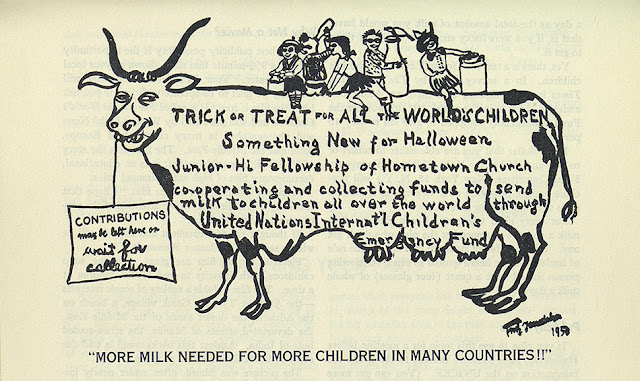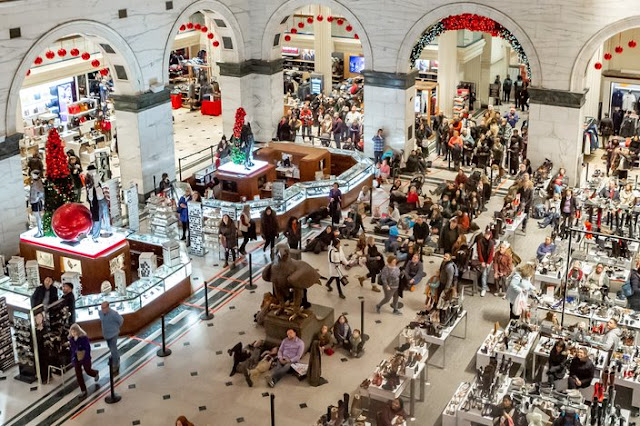A Little History - A Halloween Cow, Sabotage in Congress, and A Red Santa Claus Saves Greeting Cards
A Cow Leads the way to Halloween
The winter of 1950 was approaching and Mary Emma Allison needed new coats for her three young children. She herded the children out on a shopping expedition down Market Street in Philadelphia. Along the way they met a little parade, led by a cow carrying banners that read, “One cent will buy 20 glasses of milk.” A group of children dressed in the national costumes of several countries followed the cow. Mary Allison and her children were intrigued by the idea of a cow in a big city, so they followed.

1950 - A Later Drawing of the UNICEF Cow by a few of the Kids Involved

The cow and its little procession led Mrs. Allison and her children right into the center of Wanamaker’s department store. There at a table collecting donations and handing out pamphlets sat the organizer of the parade, Gertrude Ely. As Helenka Pantaleoni later put it, " Ely was busy telling everyone who passed, what a wonderful thing UNICEF was, and here was Elsie, the Cow, collecting for UNICEF, for milk for children.΅

1950 - A Later Drawing of the UNICEF Cow by a few of the Kids Involved

Wanamaker's Department Store, Philadelphia
The cow and its little procession led Mrs. Allison and her children right into the center of Wanamaker’s department store. There at a table collecting donations and handing out pamphlets sat the organizer of the parade, Gertrude Ely. As Helenka Pantaleoni later put it, " Ely was busy telling everyone who passed, what a wonderful thing UNICEF was, and here was Elsie, the Cow, collecting for UNICEF, for milk for children.΅
 |
| Gertrude Ely |
Gertrude Ely was much more than just an innovative fundraiser for UNICEF. She was also a close friend of Eleanor Roosevelt, as well as a national hero in both the US and France. France had twice awarded her the Croix de Guerre for bravery under fire for her service during World War I. Now she was deeply committed to the cause of the United Nations and particularly to UNICEF.
A brief discussion followed between the two ladies. Mary Allison explained that she and her husband, Clyde, had been raising funds and collecting donations of shoes for children in Europe since the end of the war, but lately the project had run out of steam as the situation in Europe had improved and US interest waned.
Clyde Allison was a Presbyterian minister in Philadelphia who had been raised in China by missionary parents. Now Mary Allison returned home from Wanamakers and announced, “Clyde, I found it! Wouldn’t it be amazing if we went trick-or-treating for UNICEF?”
And so they did - first with their own children and later with children of their church. They dressed the kids in national costumes, often altering clothes Clyde had brought back from China. They used empty milk cartons from school to collect the money, precursors of the later orange boxes used by UNICEF.
 |
| Pastor Clyde gives a pep talk to the kids |
As their eldest daughter Mary Jean, later told it, “We were real little, and my mother was behind us, and we were trying to explain it, and there were these memories of terror, actually. But people are generous. We got money and candy, so my parents knew it was a go....(they) turned us into little UNICEF ambassadors. If you tell children how much power they have - a dime can buy 50 glasses of milk - that’s really powerful. ”


 |
| Mary Emma Allison and her children |
A member of Maurice Pate’s staff, Betty Jacob, heard about the efforts of the Allisons and asked Pate to give UNICEF funds to publicize the trick-or-treat idea. Pate was reluctant to use UNICEF funds, but instead reached in his own pocket to provide the cost of publication. Clyde Allison's article attracted great attention form church and community groups, and soon took off in the media. By 1951 news articles and photos were appearing all over the US of children going door to door at Halloween, carrying their milk cartoons to collect donations.
Sabotage in Congress
 |
| John Bell Williams |
Bell was a staunch segregationist, opponent of foreign aid, and anti-communist crusader. He was later best known for his vocal opposition to desegregation and his efforts to undermine US anti-poverty programmes.
Fast work by the Citizens Committee led to calls and letters from the public to members of Congress. The New York Times and other publications picked up the story, and soon other members of Congress came out strongly in favor or restoring funding.
Fast work by the Citizens Committee led to calls and letters from the public to members of Congress. The New York Times and other publications picked up the story, and soon other members of Congress came out strongly in favor or restoring funding.
As Helenka Pantaleoni told it, “This is the way things happen. And it took an awful lot of fancy foot-work to rectify the situation, the US made it up eventually. They did pay it back, but it took a lot of doing and pulling and filling. You can see that these were very hazardous times.”
“ The idea began with Nora Edmunds of House and Garden magazine. She told Maurice Pate that it would be nice to have a card for the benefit of UNICEF. Mary Lord, who chaired the US Committee did not have enough staff to handle it, so UNICEF’s director of public information, Gil Redfern took the idea instead to Kay Bryan who ran the UN Information Center. The original card was sold just among UNICEF personnel. That was the one made by Dzitka, a 7 year old girl from Czechoslovakia.
Bizarre things happened which are hard to believe. The fate of a project, like the fate of an organization, sometimes hangs on a particle. As it was touch and go with UNICEF, so it was touch and go with the cards.
Greeting cards - After all, Santa wears red too!
Here Helenka Pantaleoni tells the story. |
| Nora Edmunds |
“ The idea began with Nora Edmunds of House and Garden magazine. She told Maurice Pate that it would be nice to have a card for the benefit of UNICEF. Mary Lord, who chaired the US Committee did not have enough staff to handle it, so UNICEF’s director of public information, Gil Redfern took the idea instead to Kay Bryan who ran the UN Information Center. The original card was sold just among UNICEF personnel. That was the one made by Dzitka, a 7 year old girl from Czechoslovakia.
Bizarre things happened which are hard to believe. The fate of a project, like the fate of an organization, sometimes hangs on a particle. As it was touch and go with UNICEF, so it was touch and go with the cards.
Some very conservative friend of Maurice Pate called him up and asked why the cards were imprinted in red, when red was a commuist color?
Well, Maurice Pate was so….he cared so about the integrity of the cause that he worried about any criticism. He stopped the presses for a while, wondering whether we should continue the cards. Like all great people, he had little foibles, and one of his foibles was that he’d rather almost scrap the whole thing than run the risk of having it considered a communist organization.
I remember the tears and screams that went on from Nora Edmunds who started this project - she was a very emotional woman. She said, ‘Oh, they’re going to ruin this whole thing.' And our volunteers were almost crazed too, because they were told to stop the addressographs!
I remember the tears and screams that went on from Nora Edmunds who started this project - she was a very emotional woman. She said, ‘Oh, they’re going to ruin this whole thing.' And our volunteers were almost crazed too, because they were told to stop the addressographs!
We finally had to say, 'Well, Maurice, Santa Claus’ suit is red too !'
Absolutely bizarre. "
Trick or Treat for Halloween 2021 style


Fascinating history of Trick or Treat and UNICEF greeting cards. Thanks for sharing! Doreen
ReplyDeleteAwesome article. As Rep, I worked closely with our GCO staff in the field in Colombia .In Bolivia, we organized an invite to artists to prepare art for an exhibition /competition on themes dealing with the mother and child. The end result involved many wonderful paintings that were studied as possible GCO greeting cards. One was actually selected and became one of our Christmas cards. Three others of the paintings are hanging on our living room wall. Similarly in Nairobi, we did the same and 2 of the art works are also hanging. Our efforts gave the artistic world a great boost because most all the paintings were sold at the exhibitions. The process gave a great impetus to our GCO sales. I was saddened when UNICEF dropped GCO.
ReplyDeleteThis comment has been removed by the author.
ReplyDeleteWhat a sparkling account of the early days of UNICEF.
ReplyDeleteGreat thanks for this important & wonderfully entertaining article, Tom.
A great bit of history, beautifully presented. About 20 years later I took on a hobby of looking for local art in Indonesia (and later in Thailand, Philippines and Burma) for UNICEF greeting cards. I was successful finding eight or ten works that actually ended up UNICEF cards. This suprisingly led to me being invited to join the GCO Art Committee one year. I also found myself trying to contribute what I could to card sales campaigns in Philippines, India and Thailand. All this and so much more because of some people had some really great small ideas. I always felt that much of UNICEF's enduring positive image around the world was due to the cards.
ReplyDeleteSteve
Great history, I love especially the cow - should have been part of the cow parade in NY some years back. And the comment about Santa wearing a red cape is priceless.
ReplyDelete